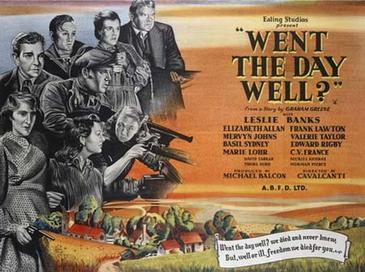One of the most evil men of the 20th
Century was assassinated on May 27, 1942.
This is the story of that act of heroism. “Anthropoid” was directed and co-written by
Sean Ellis. He filmed the movie on
location in Prague and had a replica of the Orthodox Cathedral where the siege
took place built on a back lot. The
movie takes its name from the operation toassassinate Reinhard Heydrich. The word anthropoid means “resembling human
being in form”. This was the seventh
movie on this subject, including another one that was released in 2016
(“HHhH”). The more times Reinhard
Heydrich gets killed, the better.
The movie opens with background on the situation in
Czechoslovakia after the Munich Conference.
Hitler sends his third-in-command Heydrich (Detlef Bothe) to quell the
Resistance there. Heydrich earns the
title “Butcher of Prague” for his methods.
The Czechoslovak government-in-exile paradrops two amateur assassins
into Czechoslovakia. Josef Gabcek
(Cillian Murphy) and Jan Kubis (Jamie Dornan) hook up with the Resistance. The locals are not thrilled with Operation
Anthropoid because of the repercussions and the fact that it is
impossible. The duo are put up with a
family and develop relationships with two females because romance and espionage
go together in war movies. The son of
the family wants to be a violinist. That
is not going to happen. The movie covers
the plotting. The head of the Resistance
is against the mission and gets the Czechs in London to order a stand down, but
word arrives that Heydrich is going to be transferred so they need to go
now. The assassination does not go
according to plan, but it is successful.
The assassins take refuge in a church and its Alamo time.
“Anthropoid” chooses accuracy over entertainment and
that is a good thing. The assassination
was meticulously restaged in real time.
This was quite an accomplishment for Ellis. The siege of the church is also highly
authentic, especially given that the setting was recreated with a lot of
effort. So I can forgive some of the
triteness of the buildup to the action scenes.
The romances don’t seem true to life.
Each hero gets a girl. At one
point they go to a dance filled with Nazis.
Defying reason is no excuse for getting some period touches in and to
show that Josef is a no-nonsense kind of guy.
Christ, he’s played by Cillian Murphy.
Isn’t that enough character development?
Jan goes through the trope of stressing over his role, but he manages to
pull it together, naturally. Dornan is pedestrian. The rest of the cast handles their stock
characters competently. It would have
been nice if the movie had personified Heydrich. He is the villain in name only. We do get a loathsome traitor to hiss at.
The movie really steps it up in the second half. The assassination scene is helped if you know
that they are restaging it. Otherwise it
comes off a bit disappointing. The siege
of the church is gonzo. There is a lot
of action of the modern variety. You
also get a lot of German soldiers charging into the open to get mowed
down. If you think this is leading up to
a happy ending, then remember that the movie is admirably accurate.
If you missed the first six movies about the
assassination of Heydrich, “Operation Anthropoid” is a good history
lesson. It could have been more
entertaining, but probably at the expense of fidelity to the truth.
GRADE = B
HISTORICAL ACCURACY:
Reinhard Heydrich was one of the architects
of the Holocaust. He was second only to
Himmler in that respect. He oversaw the
Wannsee Conference which initiated the Final Solution. Hitler did send him to Prague to put down
Czech resistance. The British Special
Operations Executive trained several Czech and Slovak operatives to assassinate
him. The Czech government-in-exile approved
the operation. Kubis and Gabcik were
parachuted into Czechoslovakia. Kubis
was injured on landing and was treated by a Resistance member. The movie is accurate in depicting that some
of the Resistance were against the mission and tried to get it called
off. Ladislav Vanek was one of them and
when he was arrested, he ratted out the cell.
In the assassination attempt, Josef’s gun did misfire and Jan threw a
bomb that blew up under the running board, injuring Heydrich. Jan and Josef escaped with Heydrich’s driver
pursuing. Heydrich was taken by a supply
truck to a hospital. He died eight days
later from sepsis. Keral Curda was the
Resistance member who gave away the safe house in exchange for money. (He was executed after the war.) The mother did
take cyanide in the bathroom as shown in the film. Her son Atec Moravec (the violinist) was
tortured which included being shown his mother’s head. Moravec told the Gestapo about the
cathedral. The siege is essentially the
same as what actually happened. Kubis,
Opalka, and Svarc were killed in the prayer loft and the others committed
suicide in the basement. The Germans did
use tear gas and water cannons. Anna
Malinova (Kubis’ girlfriend) was taken to a concentration camp and died
there. The Lenka character is
fictional.
The movie does not cover
the aftermath. The argument that the
death of Heydrich was not worth the reprisals has some merit. The towns of Lidice and Lezaky were targeted
because of a perceived connection to the assassins. All adult men were executed and the women and
children were sent to concentration camps where most perished. Around 5,000 Czechs were killed for the loss
of the one Nazi mad man. The death of
Heydrich was the only successful government-sponsored assassination of a top
Nazi during the war.
I saw the movie through a Netflix DVD.
.png)



